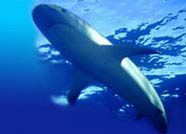


Shark Glossary

 |
 |
 |
|||
| Home | Evolution
| Classification
| Glossary | Biology
| Behavior | Shark
Repellent | Shark
Conservation | Do's &
Don'ts | Did You Know?
Shark Glossary |
 |
||||
|
Early Sharks
Sharks have existed for over 350 million years. They evolved over 100 million years before the dinosaurs did. This was long before people evolved. Most fossil evidence of early sharks is from fossilized teeth and a few skin impressions. Cladodonts, primitive sharks, had double-pointed teeth, were up to 3 feet (1 m) long fish-eaters and lived about 400 million years ago (mya). The earliest-known primtitive shark remains are fossil "scales" that date from about 420 million years ago, during the early Silurian. The earliest shark genera are Mongolepis, Polymerolepis, and Palaeospondylus. Ears Sharks are very sensitive to low frequency sounds and have good directional hearing. The endolymphatic pores on the top of a shark's head are the only external evidence of its ears. Inside the endolymphatic pores are the endolymphatic ducts which lead to the macula neglecta and a series of semicircular canals with which sharks hear.
 Eel
Shark Eel
SharkChlamydoselachus anguineus, also known as the frilled shark, is a long, thin shark with a very long tail fin and a short snout. It grows to be up to 6.5 feet (2 m) long and is a light-brown color. It has 6 pairs of long gill slits (6 slits on each side of the body behind the head). Each gill slit is covered by frills of skin, hence its name. Its teeth have 3 cusps on a wide base. It has an anal fin and one small dorsal fin. The pectoral fins are short and rounded. The frilled shark is viviparous, giving birth to 8 to 12 live young in a litter after a gestation period of about 1 to 2 years. Pups are about 16 inches (40 cm) long. This shark is harmless to people and is found in the eastern Atlantic Ocean, the eastern Pacific Ocean, and the western Indian Ocean. It generally lives deep in the ocean (about 330-4,260 feet or 100-1,300 m deep) but is occasionally found at the surface. Very little is known about this shark. (Order Hexanchiformes, Family Chlamydoselachidae) Elasmobranchii Elasmobranchs are cartilaginous fish that have an upper jaw that is not fused to the braincase, no swim bladder, an advanced electroreceptive system, a spiracle, skin with placoid scales, teeth that are modified placoid scales, and 5-7 separate slit-like gill openings. These include the 600 species of sharks, skates, and rays.  Eye EyeShark's eyes vary in shape and size among the different species. Also, only Carchariniformes sharks have a nictitating membrane. Sharks have keen vision and can see very well, even in dim light (using the tapetum lucidum). Shark eyes have a spherical lens. |
|
||||||||||
| Sitemap | Reach To Us | Jimtrade - Business Directory of India | |||||||||||